Hoya obovata have instantly recognizable deep green oval leaves with a splash of silver or cream variegation. And those flowers.
(It’s no wonder Hoya are some of the most popular indoor plants!)
As Hoyas climb tree trunks in their natural habitat, indoors you can twine them around a circular wire hoop, let them trail from a hanging basket, or get a moss pole involved. Obovata options are the best, aren’t they?
Hoya obovata care is actually really easy. They feature semi-succulent leaves which means they only need infrequent watering. The payoff? Definitely their vibrant five-point flowers.
Let’s explore the history of Hoya obovata plants, how to grow them indoors, and favorite propagation tricks.
We’ll also cover the most common issues we see with these plants (don’t worry, there aren’t many).
Table of Contents
Hoya Obovata Care Guide
History, habitat, and characteristics

Starting with the basics — Hoya is the master genus of Apocynaceae in Asia, with over 520 species and growing all the time. Hoya obovata is one of them.
This plant is an epiphyte with aerial roots, which means it clings to and winds its way up the trees in the forests of its native Indo China habitat to get the sunlight and nutrients it needs. (This is a great reason to train them up moss poles).
This plant has obovate, or oval, thick green leathery leaves (hence the name “obovata”). Similar to a succulent, its leaves are designed to store water, which makes it drought-tolerant and really easy to care for.
That might be where the scientific agreement ends, though. You see, there’s a bit of a classification snafu to this day thanks to three botanists from different countries, our good friends Joseph, William, and Julien.
Classification Kerfuffle: The Name Game
Joseph Decaisne, a Belgian botanist and the director of the Jardin des Plantes in Paris, first wrote about Hoya obovata in 1844. British botanist William Grant Craib described what he thought was H. obovata var. kerrii in 1911.
It wasn’t until French botanist Julien Noël Constantin recognized what he labeled as two different varieties, Hoya obovata var. obovata and H. obovata var. kerrii (Craib), in 1912 that things really got interesting, though.
Wait, kerrii? Yes, that one! The darling plant with heart-shaped leaves. Botanists know the two are related, but no one is sure exactly how yet, pending more research. Is Hoya kerrii really a variant of Hoya obovata like Craib and Constantin thought, or its own species? To be determined.
Some people even claim there is a cross between the two out there, but we haven’t been able to find anything definitive. I’m on the edge of my seat! If you know anything, give us the inside scoop. Speaking of variants and hybrids, here are some we do know about.
Hoya Obovata Varieties
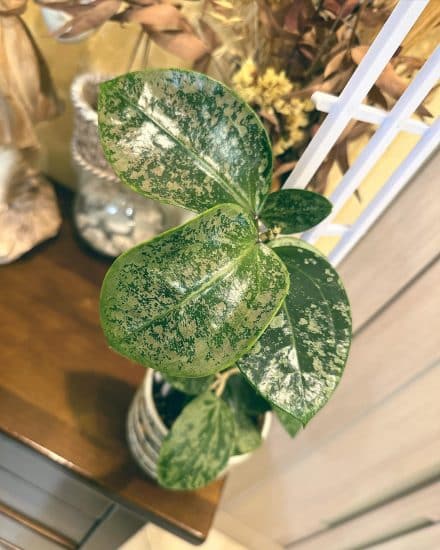
Hoya obovata have some of my favorite variegation — their speckling and mottling makes me think of tiny saucer-shaped planets.
- Hoya Obovata ‘Splash’, also known as Hoya obovata ‘Variegata’ – oval green leaves splashed with silvery speckles
- Hoya Carnosa ‘Majic’, also known as Hoya carnosa ‘Variegata’ – a cross between Hoya obovata and Hoya carnosa, with wide, round, lighter green leaves splashed with cream and yellow, and pink stems
And before you ask, yes, both variants put out the cute waxy flowers this species is known for!
Hoya Obovata Flowers

As it grows, Hoya Obovata produces clusters of gorgeous, star-shaped white or pink flowers with soft, waxy petals and pink or red centers. Flowers are tiny, only 2 to 3 centimeters across, with an eye-catching glossy shine.
Generally, it takes three years for Hoya obovata to flower, so don’t be worried if you have a young plant and you don’t see any blooms yet.
Aside from its variegated leaves and vivid blooms, this houseplant is wildly easy to care for. All it needs is bright light, occasional watering, and some humidity to help it thrive. Let’s find out how!
Light
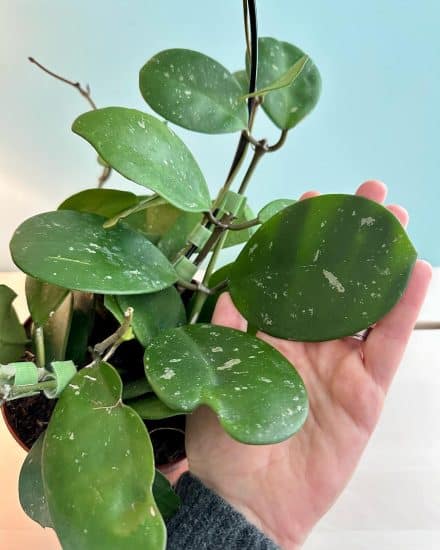
Hoya obovatas love bright indirect light, but they can also take a few hours of direct sunlight — note the “few”! Too many hours in a south-facing window (all direct light, all the time) can burn your plant’s foliage, leaving it with yellow or brown edges and patches along the veins.
On the other hand, if the hoya isn’t receiving enough light, it’ll start to look pale green, then yellow, and its leaves will get soft and droop.
For best results, put your Hoya near an east or west-facing window so it can soak up that bright indirect sunlight. A north-facing window will also work, although the light won’t be quite as bright.
Tip: Rotate your plant every week or so to make sure its leaves get an even amount of light.
Aim for more light if you want to encourage blooming! If you need to supplement your hoya’s light levels, consider getting an artificial light (I recommend an LED grow light to save on energy costs).
The minimum amount of light your plant needs is 1,500 lux, but it should ideally receive 2,500 to 3,000 lux for about 10 to 12 hours a day. Over this level and timeframe, and you risk scorching its leaves.
Water
Like other hoya plants, this tropical beauty isn’t a fan of overwatering. You can check the soil with a finger to see if it’s moist one or two inches down. If so, wait to water. If not, break out the watering can.
A good rule of thumb with this plant is, when in doubt, water less. Remember that this plant stores water in its leaves, so it’s got an added defense against dry soil.
When you do water Hoya obovata, use lukewarm water to avoid shocking it. Tap is fine, but distilled, filtered, or rainwater is preferable if you have it to prevent salt and other chemical buildup in the soil.
Using the finger in soil test, you’ll have to water every week or two in the warmer months. When winter hits and the temperatures drop, you’ll want to reduce watering frequency to about once a month. Keep an eye out for limp or yellow leaves, which means your plant either wants a drink or is getting too much water.
Make sure the pot you choose has at least one drainage hole and that your hoya isn’t left in waterlogged soil, which can cause root rot. Think moist but not totally drenched.
Temperature and humidity
Hoya obovata plants do well in a wide range of household temperatures, from 60°F all the way to 85°F — positively beachy! Keep your hoya away from drafts around windows or air conditioners, since it won’t fare well with those colder temps.
Since it’s a tropical plant, your hoya prefers moderate to high humidity similar to its native habitat, anywhere from 50% to 60% or higher. If you want to get a more accurate sense of the humidity levels around your plant, you can pick up an inexpensive hygrometer.
What should you do when the air around your plant gets a bit drier than ideal? Use a humidifier to raise the moisture level when it drops too low, or group together multiple plants so they can share moisture and create their own humid microclimate. You can also put your plant on a pebble and water tray.
While you can mist your hoya’s leaves, keep in mind that this isn’t the best long-term way to raise humidity — it’s more of a temporary solution, and is honestly better for clearing away potential pests than anything else. Make sure to wipe your plant’s leaves down after misting so they don’t run the risk of rotting.
Soil and planting
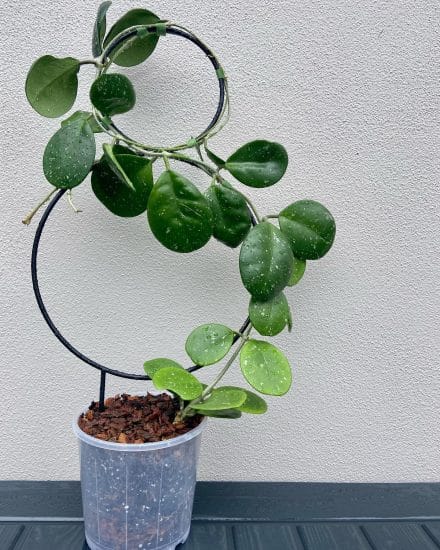
With Hoya obovata care, the soil mix is critical. This lovely species prefers a slightly acidic, well-draining potting soil with a pH of 6.0 to 6.5 that still retains moisture. You can use a good succulent mix, or create your own if you’d like.
Either way, an ideal potting mix should have ingredients that lighten up the soil and let your plant’s roots breathe while giving them just enough water. Orchid bark, perlite, pumice, and coco coir all fit the bill.
(Optional: You can add horticultural charcoal to help remove excess water and purify the potting soil.)
Pruning
As always, cut off any brown sections. And when your Hoya obovata stems start getting leggy, prune them so the plant can expend energy getting bushier and growing more stems closer to its base. Plus, you can use any cuttings to propagate more plants!
Repotting

Hoyas actually enjoy being a bit root bound. While Hoya obovata grows slightly faster than other hoya varieties, it will likely only need repotting every few years. When the time rolls around, your plant doesn’t need a deep pot, since its roots are fairly shallow (remember, it’s a climber!). In fact, using a pot that’s too deep could cut off oxygen for the roots.
Just make sure the container you use isn’t too big (only an inch or two bigger than the previous pot), has an appropriate drainage hole or two, and you should have smooth sailing (growing?). Just remember the fresh potting mix.
Fertilizing
Fertilize your Hoya with a balanced liquid houseplant fertilizer diluted to 50% every month in spring and summer when it’s actively growing. Take a break during the fall and winter months when your plant will be dormant and unable to take up the nutrients. Over-fertilizing in winter could lead to wilting or scorched leaves, and nobody wants a burnt Hoya obovata.
Okay, you’re familiar with everything your hoya plant could possibly need, but how do you make more of them so others can enjoy them too? Let’s talk propagation!
Propagation guide
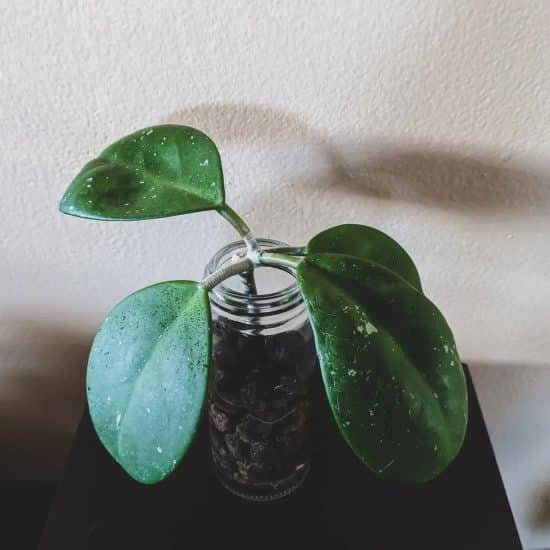
You can propagate Hoya obovata by stem cuttings and division. Stem cuttings are the easier route, but consider division if you want a challenge and a full plant more quickly.
To propagate Hoya obovata by stem cuttings:
- Take a healthy 4 to 6-inch stem cutting of the Hoya obovata with at least two nodes (where the leaves emerge from the stem) using sterilized shears.
- Optional for soil planting: Dip the cutting end into a rooting hormone.
- Stick the cutting into either a jar of water or moist, well-draining soil in a pot. Nodes should be under the water or soil, but not any leaves! If there are leaves on the bottom of the cutting getting submerged, cut them off.
- Place the jar or pot in a warm area with indirect sunlight or under grow lights. For soil planting, keep the soil consistently moist and don’t let it dry out.
- Be patient! It usually takes 3-4 weeks for your cuttings to develop more extensive roots, but you should start to see new growth from the cutting within the first few weeks. If growing your hoya in water, transplant it to soil when roots are at least one or two inches long. And voilà, you’ve done it!
To propagate Hoya obovata by division:
Remove the plant gently from the pot and dust off its roots. Use sharp shears or a knife to cut off a piece of the plant with a sizeable root structure. Put it in soil. And that’s it! Enjoy your new hoya!
Now you can share your hoya with friends and fam, but do you know what to do if leaves go limp or bugs invade?
Common issues

Fortunately, there are easy fixes for all common hoya issues, so let’s get into them!
Deformed or Bumpy Leaves
In my experience, when your Hoya’s leaves come out bumpy or just generally malformed and different than the perfectly round ones you’ve come to expect, it’s due to lack of water or light. This is also the culprit of . . .
Discolored Leaves
You’re either under or overwatering the plant, or giving it too much or too little sun. But those are opposing problems! Sure, but they’re easily investigated. If leaves are turning brown and wrinkling, they’re either getting too much sun or water. If the soil is dry, water it. If the soil is moist, move the plant farther away from the window and make sure it only gets bright indirect light.
Yellow Leaves
If your Hoya obovata’s leaves are yellowing and you notice consistently wet soil, 99% of the time you’re overwatering it. If the soil is dry, you’re underwatering it. Yellow leaves can also stem from too much sunlight (make sure you’ve got a curtain up to diffuse any direct light) or too little sunlight (supplement with grow lights if you need to.)
Weak Stems
Again, a water or sun issue. In this case, your plant’s stems are reacting to overwatering or lack of light. At this point, you know what to do! Give a dehydrated plant a drink and protect it from those harsh UV rays.
Diseases and pests
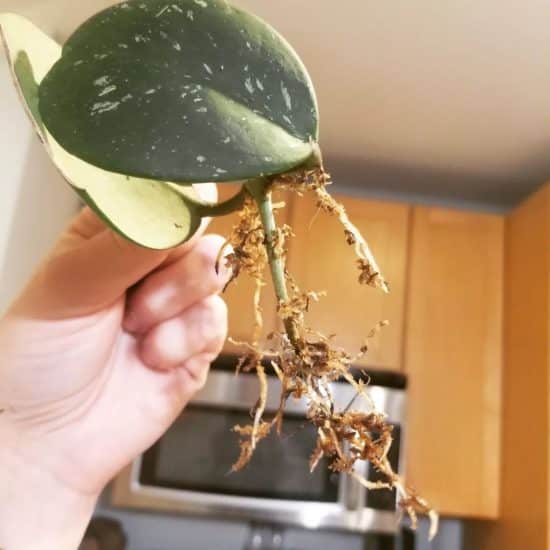
Hoya obovata plants can fall prey to fungus, root rot, and bugs like many other plants. We’ll help you figure out how to deal with all of it stress-free.
Fungal Infections
Hoya Obovata is prone to fungus, usually from too much water or sunlight, that can cause yellowing and brown spotting of the leaves or sooty mold. What to do? Isolate the plant from others and trim off any affected leaves to stop the problem from spreading. Treat your plant with a diluted liquid fungicide, making sure to follow the directions on its label.
Root Rot
As with most plants, root rot can also be problematic for the hoya obovata and stems from overwatering or poor drainage. Symptoms include mushy, discolored, smelly roots. To solve this issue, pull the plant out of its soil and check its roots. Remove any mushy or discolored sections, then repot in fresh dry soil. Make sure to use a pot with drainage holes and allow the soil to dry out between waterings.
Bugs
Keep your eyes peeled for mealybugs (oval cottony masses), fungus gnats (tiny black/gray bugs) or spider mites (red, yellow, or orange dots). If you do have any infested plants, isolate them immediately. Use cotton swabs or gentle water sprays to eradicate any white fuzzy bits or visible pests from stems and leaves. Treat your plant with a gentle soapy water solution, diluted neem soil, or insecticidal soap.
Conclusion

From its easily recognizable dark green waxy leaves to its beautiful white and pink flowers, Hoya obovata is the perfect addition to any indoor garden.
These semi-succulent epiphytic plants thrive in indirect sunlight, although they can tolerate bright direct light for several hours daily. Train them up a moss stick or let them trail from a hanging basket like leafy round birds, it’s your choice.
Care summary:
- Use well-draining soil. Soggy soil is a recipe for pests and potential rot.
- Propagate by stem cutting or division.
- To really ensure a fast-growing healthy plant you’ll want to keep things humid. Consider a humidifier, pebble tray, or clustering your plants together.
If you found this article useful, send it to a fellow Hoya-owning pal. And feel free to ask us any burning plant care questions — we’re here to help!
FAQ
Is Hoya Obovata fast-growing?
Compared to other hoyas, this one grows more quickly. But you still won’t need to repot it more than once every few years, so take that as you will.
What does Hoya Obovata smell like?
Hoya obovata’s flowers smell pleasant and sweet, like a cross between a rose and a carnation (to me). Some people have reported picking up on a slightly pungent undertone.
Is Hoya Obovata toxic?
According to the University of Nebraska-Lincoln’s Institute of Agriculture and Natural Resources, hoyas are nontoxic, so they’re safe to have around your little ones and furry friends.
How big do Hoya Obovata get?
Indoors, this plant can get up to 10′ to 12′ tall. Outdoors, quite a bit bigger.
How do you get Hoya Obovata to flower?
Light, light, and more light. And time. Only mature hoyas bloom. Try to keep them rootbound (i.e., don’t repot too frequently). And when Hoya obovata flower and the blooms run their natural course, don’t pinch off the dead stalk, since they’ll bloom from it again later!
Sources
- https://powo.science.kew.org/taxon/urn:lsid:ipni.org:names:98591-1
- https://www.rhs.org.uk/plants/82298/hoya-obovata/details
- https://www.researchgate.net/profile/Sri-Rahayu-5/publication/366661144_Hoya_of_Sulawesi_Indonesia_A_checklist_two_new_species_a_new_subspecies_and_six_new_records/links/63b788d0097c7832ca946286/Hoya-of-Sulawesi-Indonesia-A-checklist-two-new-species-a-new-subspecies-and-six-new-records.pdf
- https://link.springer.com/chapter/10.1007/978-3-319-93605-5_3


